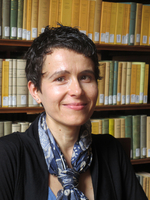Dr. Kristine Iara
kristine.iara@uni-erfurt.deJunior Fellow (Max Weber Centre for Advanced Cultural and Social Studies)
Office hours
nach Vereinbarung
Visiting address
Max-Weber-Kolleg für kultur- und sozialwissenschaftliche Studien
Campus
Nordhäuser Str. 63
99089 Erfurt
Mailing address
Universität Erfurt
Max-Weber-Kolleg für kultur- und sozialwissenschaftliche Studien
Postfach 90 02 21
99105 Erfurt

Zur Person
Forschungsprojekt
Late antique Rome : Space, people and gods
The project on which I intend to work during my stay as a fellow at the Max Weber Center within the ‘Religion and Urbanity’ Research Group is entitled Late antique Rome: Space, people and gods and it is part of my ongoing post-doctoral research project (Classical Archaeology, projected as monographic study) in an advanced stage on the sacral topography of the city of Rome in Late Antiquity (approx. 300 to 600 CE).
In Late Antiquity, a period of profound transformations in political, social, economic and religious terms, both the physical appearance of the city of Rome and the civic and religious life of its inhabitants were fundamentally changing. Based on the analysis of the archaeological, epigraphic and textual evidence and its critical assessment, my research explores the topographic-urbanistic, social, and religious dimensions of the transformation of Rome’s sacral topography in this period.
My methodology can be subsumed under the term synopsis and includes: (1) studying the late antique period as intrinsic to Rome’s millennial history, without being biased by a teleological view on the outcome, that is, Rome as the capital of a Christian empire; (2) analyzing all cult places and all areas of the city, including the suburbium; (3) the combined consideration of the dimensions of space and time; and (4) examining connections and connectors (material, permanent ones, e.g. streets; ephemeral ones, e.g. processions; immaterial ones, e.g. visual axes). This synoptic analysis of the cityscape constitutes the essential step that leads not only to a quantitative increase of data, but will induce a qualitative shift in the research. Moreover, it will re-embed Rome’s sacral topography within its topography without the two being separated from one another. Rome’s sacral topography has not yet been analyzed with a similar approach, neither for Late Antiquity nor for earlier times.
In earlier stages of my research, I laid the groundwork by cataloguing, mapping and writing down the ‘biographies’ of the built, spatially fixed elements of Rome’s sacral topography, addressing issues such as the arrangement, disposition, distribution and integration of sanctuaries and cult places in Rome’s urban tissue; relations between sanctuaries and between sanctuaries and buildings of other purposes, and more. Further, I examined several processional movements which are, as ephemeral components, as important for Rome’s sacral topography as the permanent structures. For Late Antiquity in particular, the possibility of shifts in preferred positioning of cult places compared to earlier periods is to be considered, as well as parallel or antiparallel developments in one and the same area or in the case of sanctuaries of one and the same deity. Last, the emergence of the new Christian religion had an impact on Rome’s sacral topography, too, either by means of legal measures or by the normative power of attaining a critical mass: we have to consider the possible influence of nearby Christian cult-buildings on already existing cult places and examine an eventual competing appropriation of space for religious purpose or the sharing of places, in indifferent or symbiotic mutual tolerance. In a further research stage, I examined the people (the ‘last pagans of Rome’), focusing on the individuals rather than groups, seeking out networks, studying emotions, individual religiosity and more. I then worked on the gods in Rome and their images, how they could have been perceived by the people, on questions of divine agency and the notion of ‘presencing the divine’ in the city, linked also with issues such as the role of (religious) knowledge in generating, transmitting and manipulating the meanings of religious or religion-related objects, all within the overarching framework of ‘religious communication’.
During the research stay at the MWK, I intend to further the focus on the dimension of space within my project, all the more as it turns out that all the other aspects ultimately gravitate around space, being the fundamental setting to enable religious communication between gods and humans to take place and to put them into relation. The research questions related to space I aim to address are interrelational and interdependent, which also reflects the relationality of the Romans and space on the one hand, their gods and space on the other. The very object of my study – the city of Rome, the urbs par excellence and quintessence of urbanity in classical antiquity – on the one hand, reciprocal transformation of religion and city – a significant factor already in Imperial times and, all the more, in Late Antiquity – on the other, offer a wide range of possibilities for interaction with and enhancement through the research focus of the KGF ‘Religion and urbanity’.

